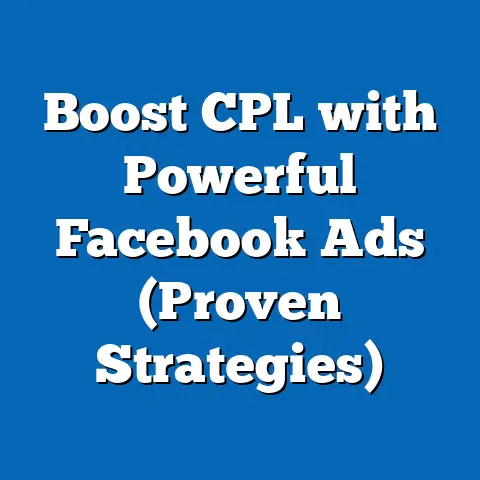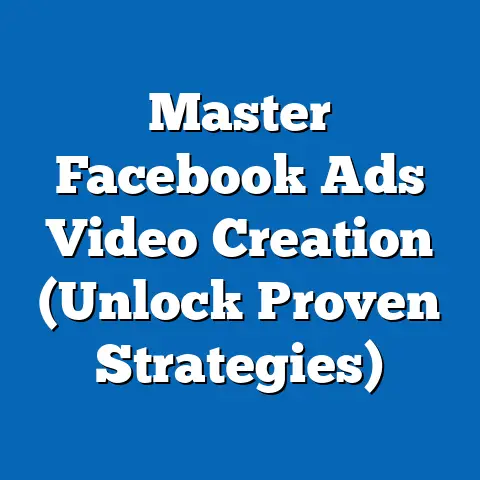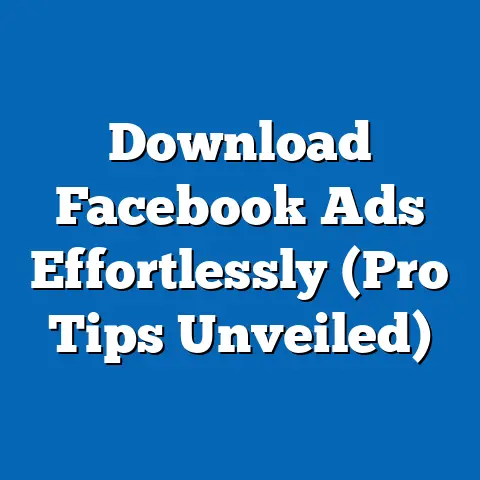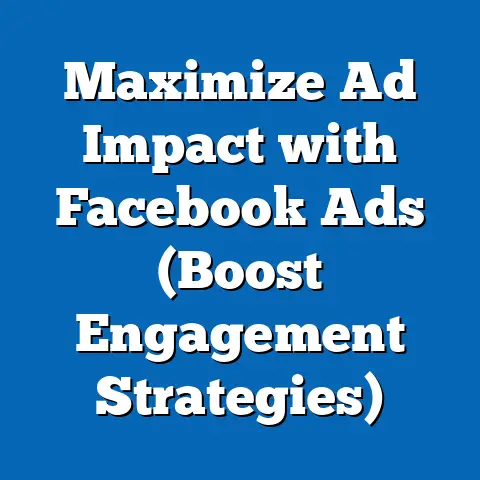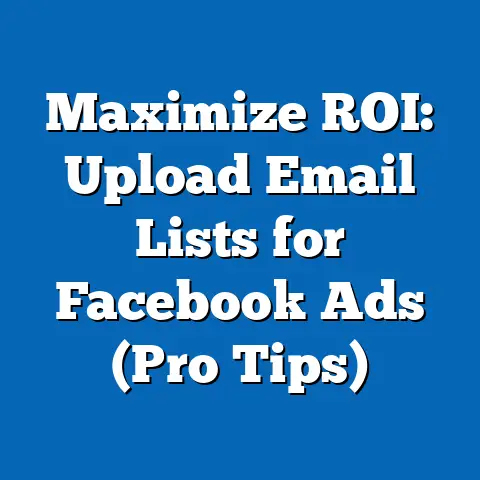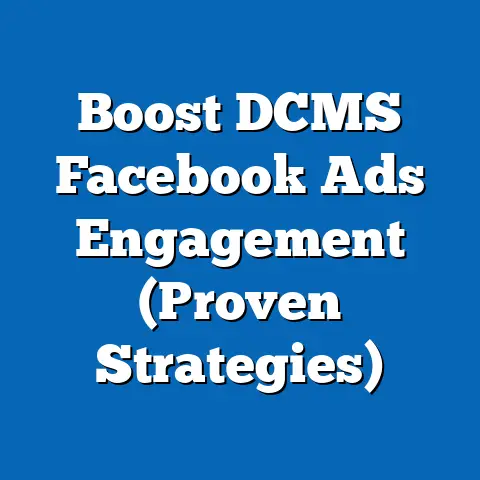Optimizing Facebook Ads Size for 2025 (Future-Proof Strategies)
“Great Scott!” As Doc Brown would exclaim, the world of advertising is constantly evolving, sometimes at what feels like warp speed. Just like Marty McFly needed to adapt to the future in “Back to the Future,” we, as marketers, need to be prepared for what’s coming. We can’t just rely on what worked yesterday; we have to anticipate the changes and optimize our strategies for the future.
Facebook ads are a cornerstone of many digital marketing strategies. But in a rapidly changing digital landscape, staying ahead of the curve is crucial. One often overlooked aspect is the size of our ads. As technology evolves and user behavior shifts, the optimal dimensions for Facebook ads change too. That’s why we need to start thinking about 2025 now and how we can future-proof our strategies, especially when it comes to ad sizes. I’ve seen firsthand how adapting to these changes can significantly impact campaign performance, and I want to share my insights with you.
The Evolution of Facebook Ad Sizes
To understand where we’re going, we need to understand where we’ve been. The journey of Facebook ad sizes is a fascinating reflection of the platform’s growth and the evolving needs of advertisers and users.
In the early days of Facebook advertising, things were much simpler. We primarily had basic image ads with limited character counts. The focus was on getting a message across quickly and efficiently. The sizes were relatively standardized, and the options were limited.
As Facebook grew, so did its advertising capabilities. New ad formats emerged, like video ads, carousel ads, and collection ads. Each format came with its own set of recommended sizes and specifications. This evolution was driven by the desire to create more engaging and interactive experiences for users. I remember when carousel ads first came out; they were a game-changer, allowing us to showcase multiple products or tell a story in a single ad unit.
Over the years, Facebook has consistently adapted ad formats to better suit user behavior. With the rise of mobile, for example, vertical video ads became increasingly important. The platform has also introduced features like Instant Experiences, which provide a full-screen, immersive experience within the Facebook app. All of these changes have had a direct impact on the recommended ad sizes and aspect ratios.
Understanding this historical context is crucial. It helps us recognize that change is constant and that we need to be prepared to adapt our strategies accordingly. By studying past trends, we can better predict future requirements and set ourselves up for success in 2025 and beyond.
Takeaway: Understanding the historical evolution of Facebook ad sizes provides a crucial foundation for predicting future trends and preparing for upcoming changes in ad specifications.
Current Best Practices for Ad Sizes
Let’s dive into the current landscape. As of today, Facebook recommends specific sizes for different ad types to optimize user engagement and conversion rates. Here’s a rundown of some of the most common ad formats and their recommended dimensions:
- Image Ads: For single image ads, the recommended size is 1200 x 628 pixels. This ensures that your image looks crisp and clear across different devices. I’ve found that using high-quality images is essential for capturing attention in the crowded news feed.
- Video Ads: Video ads are incredibly powerful, but they need to be properly sized. For in-feed video ads, Facebook recommends a resolution of 1080 x 1080 pixels (square) or 1080 x 1920 pixels (vertical). Vertical videos have become increasingly popular, especially for mobile viewing.
- Carousel Ads: Carousel ads allow you to showcase multiple images or videos in a single ad unit. The recommended size for carousel images is 1080 x 1080 pixels. This format is great for e-commerce businesses that want to display multiple products.
- Collection Ads: Collection ads are designed to drive product discovery and sales. They typically feature a cover image or video followed by a selection of products. The recommended size for the cover image or video is 1200 x 628 pixels.
These recommendations aren’t arbitrary. They’re based on years of data and testing. Facebook’s algorithm is designed to optimize ad delivery based on these specifications. When you adhere to these best practices, you’re more likely to see better engagement and conversion rates.
I’ve personally seen the difference that proper ad sizing can make. In one campaign I ran for a clothing retailer, we initially used images that were slightly smaller than the recommended size. The ads looked blurry on some devices, and our click-through rate was lower than expected. Once we updated the images to the correct dimensions, our CTR jumped by nearly 20%. It’s a small change, but it can have a big impact.
Takeaway: Adhering to current Facebook’s recommended sizes for various ad types is crucial for optimizing user engagement, conversion rates, and overall campaign performance. Don’t cut corners; pay attention to the details.
The Impact of Emerging Technologies
Now, let’s look into the crystal ball. What technologies will shape the future of Facebook advertising and, more specifically, ad sizes by 2025? I believe that augmented reality (AR), virtual reality (VR), and 5G will all play a significant role.
- Augmented Reality (AR): AR allows users to overlay digital content onto the real world. Imagine being able to virtually “try on” a pair of glasses or see how a piece of furniture would look in your living room, all through a Facebook ad. AR ads could require new dimensions or formats to accommodate these interactive experiences. We might see ads that use the phone’s camera to create a personalized AR experience, requiring specific aspect ratios and resolutions.
- Virtual Reality (VR): While VR is still in its early stages, it has the potential to revolutionize advertising. VR ads could transport users to a completely immersive environment, allowing them to experience a product or service in a whole new way. VR ads would likely require entirely new formats and sizes, optimized for VR headsets and other devices.
- 5G: The rollout of 5G networks will enable faster download speeds and lower latency. This will make it possible to deliver richer, more interactive ad experiences. We might see more high-resolution video ads, interactive ads, and even live streaming ads. These types of ads will require larger file sizes and optimized formats to take advantage of the increased bandwidth.
- Artificial Intelligence (AI): AI is already playing a significant role in advertising, and its influence will only grow in the coming years. AI can be used to optimize ad sizes and formats in real-time based on user interaction and preferences. For example, an AI-powered system could automatically adjust the size and layout of an ad to maximize engagement on different devices. I’ve personally experimented with AI tools that help optimize ad creatives, and the results have been impressive.
These emerging technologies will not only change the way we create ads but also the way users interact with them. As marketers, we need to be prepared to adapt our strategies and embrace these new opportunities.
Takeaway: Emerging technologies like AR, VR, 5G, and AI will significantly influence Facebook ad formats by 2025, potentially requiring new dimensions, interactive elements, and real-time optimization strategies.
Future-Proof Strategies for 2025
So, how can we prepare for this future? Here are some actionable strategies that you can implement now to future-proof your Facebook ad campaigns:
- Embrace Adaptive Design: Adaptive design is the key to flexibility. Instead of creating fixed-size ads, focus on creating ad assets that can be easily resized and reformatted to fit different dimensions. This means using vector graphics, scalable fonts, and flexible layouts. Tools like Adobe Creative Suite and Canva offer features that make it easier to create adaptive designs.
- Prioritize High-Quality Assets: Regardless of the size or format, high-quality assets are essential. Use crisp, clear images and videos that look great on any device. Invest in professional photography and videography if necessary. Remember, your ads are often the first impression that potential customers have of your brand.
- Test, Test, Test: Continuous testing is crucial for identifying trends and adjusting ad sizes accordingly. Use A/B testing to compare different ad sizes and formats. Pay attention to metrics like click-through rate, conversion rate, and engagement rate. Facebook’s Ads Manager provides robust testing tools that you can use to experiment with different ad variations.
- Stay Informed: Keep up with the latest news and updates from Facebook. The platform is constantly evolving, and it’s important to stay informed about new features, ad formats, and best practices. Follow industry blogs, attend webinars, and join online communities to stay ahead of the curve. I make it a point to dedicate at least an hour each week to reading industry news and experimenting with new features.
- Invest in AI-Powered Tools: As AI becomes more prevalent, consider investing in AI-powered tools that can help you optimize your ad campaigns. These tools can automate tasks like ad resizing, creative optimization, and audience targeting. While these tools can be expensive, they can also save you time and improve your results.
- Think Beyond the Screen: Consider how your ads can extend beyond the screen. Can you create ads that integrate with real-world experiences? Can you use AR or VR to create more immersive and engaging experiences? By thinking outside the box, you can create ads that truly stand out from the crowd.
- Focus on User Experience: Ultimately, the most important thing is to focus on user experience. Create ads that are relevant, engaging, and valuable to your target audience. Avoid using intrusive or annoying ad formats. Always prioritize the user’s needs and preferences.
By implementing these strategies, you can ensure that your Facebook ad campaigns are ready for whatever the future may hold.
Takeaway: Marketers can future-proof their Facebook ad strategies by embracing adaptive design, prioritizing high-quality assets, continuously testing ad sizes and formats, staying informed about platform updates, and investing in AI-powered optimization tools.
Conclusion
Just like Marty McFly had to adapt to the ever-changing timelines in “Back to the Future,” we, as marketers, must embrace change and innovation in our strategies. Optimizing Facebook ad sizes for 2025 is not just about keeping up with trends; it’s about leading the charge into the future of advertising. It’s about understanding the evolution of the platform, anticipating the impact of emerging technologies, and implementing future-proof strategies that allow us to adapt and thrive in a dynamic environment.
I encourage you to reflect on your current practices and how you can integrate these future-proof strategies into your marketing efforts today. Start experimenting with adaptive design, prioritize high-quality assets, and stay informed about the latest trends and updates. By taking these steps, you can ensure that your Facebook ad campaigns are ready for whatever the future may hold.
Call to Action:
What are your thoughts on the future of Facebook advertising? What steps are you taking to prepare for it? Share your insights and ideas in the comments below! Let’s learn from each other and build a brighter future for Facebook advertising together.

